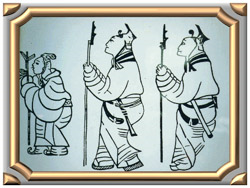
- Dynasty Eras
Precursors of the modern military police force can be traced back to the dynasty eras. According to ancient Chinese records, armed forces akin to the modern MP served from the Chou dynasty (approximately 3000 B.C), through Han, Wei, Tang, all the way to the Qing dynasty. These forces are elite guards that often if not always are responsible for not just the safeguard of the emperor and his surroundings, but also for enforcement of proper military conduct. It was not until the late Qing dynasty, in light of the invasion of the Eight Nations Alliance and Japanese influence, did the emperor finally decide to create the nation’s first Military Police units.
-Warlords Era
Qing Dynasty’s Military Police was short lived, however, as the Qing Dynasty was swiftly replaced by the advent of Republic of China. The Republic of China Military Police was founded in 1914. When the provisional president of Republic of China, Dr. Sun Yat-sen, took the office in Guangzhou, an internal security unit was established to enforce military discipline among the troops loyal to the Republic of China Provisional Government. This unit was later renamed Military Police and would gradually expand and become present-day Republic of China Military Police. In 1925, under the supervision of then general Chiang Kai-shek, the military police was expanded from a single company to a full battalion, and was attached to the Northern Expedition Forces the next year. In the next ten years, the military police gradually expanded into several regiments, and was active in purging the communist elements within the Nationalist government.
-World War II
During the Second Sino-Japanese War, the Military Police troopers sometimes found themselves clashing with the Japanese despite the fact that they were neither properly trained nor equipped for such combat tasks. In the January 28 Incident, Shanghai and Battle of Nanjing in 1932 and 1937, the Military Police put up fierce resistance against the Japanese forces, and suffered heavy casualties. The Military Police were also instrumental in operations behind Japanese line, and in time continued to expand under the direction of Nationalist Military. Military Police were also active in keeping the influences of the communists at bay, and were successful at quelling an attempted insurrection by the communists in 1941. The last task of the Military Police in the war was to provide escort to the Japanese delegates to arrange the surrender.
-Civil War
Full scale civil war broke out in 1946 between the Nationalists and the Communists; however, the Military Police were not as active in combat as they once were in the war against Japan. The Military Police were tasked to protect important governmental facilities from sabotages as well as political figures from assassinations. Furthermore, several Military Police regiments were involved in suppressing civil unrests in the newly acquired territories of Taiwan. Following the defeat on mainland, the Military Police headquarters were moved to Taipei, Taiwan in 1950 .
- Taiwan
In 1970, under the advice from the US Military Mission to the ROC, the ROC Armed Forces reorganized all their regiments into brigades. On 16 March 1970, the Military Police Command formed up four regional commands from the original military police regiments: 201st regional command from the 101st Military Police regiment for presidential guards, 202nd from the 201st MP regiment for capital garrison, 203rd from the 202nd MP regiment in Miaoli, and 204th from the 203rd MP regiment in Tainan City. The overall system has undergone significant changes over the years.
- Now
Following the Enhancement Program in 1997, the Armed Forces have undergone significant organizational changes, with the Military Police Command supervising the regional commands of Taipei City, as well as those in Northern Taiwan, Central Taiwan, and Southern Taiwan, and each of these commands supervising the Taipei City metropolitan area and the Northern, Central, and Southern Taiwan regions respectively. In addition, the Military Police School was established to train the basic cadres of the military police, as well as to provide specialized training for those serving in the military police. The command hierarchy is “Military Police Command à Regional Command à Military Police Units & Battalions à Companies à Platoons à Squads”. In addition to the command level as well as the military police units and battalions under the independent command of the Military Police Command, there are also military police units in each theater of operations. Moreover, the Military Police has been repositioned as a “protective force” to maintain the discipline of the Armed Forces and to provide support for combat operations.For example, in 2006, in accordance with the policy of strengthening the “protective forces”, the “Peace Project” was implemented, incorporating 10 security battalions of the former ROC Air Force Air Defense Artillery Command to be responsible for guarding airports. In addition, in line with the Ministry of National Defense’s “Armed Forces Refinement Program”, the Military Police has been restructured in accordance with Guo Lue Jun Bian Tzu Order No. 1010001765 from the Ministry of National Defense, turning the Military Police Headquartersinto Republic of China Military Police Command on January 1, 2013, overseeing the nation’s Military Police affairs, and organizing the three staff groups of military affairs, political warfare and surveillance. By the end of 2014, it is in charge of the Military Police Training Center, four regional commands, 21 military police units, five military police battalions, and affiliated units (with the addition of a new police and security brigade) and has been assisting in directing the military police units to carry out relevant missions based on the authority, responsibility, and direction of the Superintendent.